Getting to the (street) art of a year like no other
- Written by Alison Young, Francine V. McNiff Professor of Criminology, University of Melbourne
If there’s one thing everyone seems to agree on, it’s that 2020 was a nightmare of a year. This was the year of political crisis: not just one, but several, one after another.
Street artists have always responded to the political issues of the day by writing, painting and sticking posters on walls. What kind of street art could be seen on walls in 2020?
In the early months of 2020, Australia’s political street art was dominated by the bushfires that incinerated over 17 million hectares of land, destroyed 3,094 homes, and killed 34 people and over a billion animals.
Shocked by the severity and extent of the fires, many people, including artists, wondered whether this was no ordinary fire season. Posters quickly appeared in Fitzroy, simple sheets of paper, each with two news photos. One showed a child in a boat fleeing the fires in Mallacoota on New Year’s Day; in another, firefighters ran through a torrent of burning embers. Between the two images, block capitals stated: “THIS IS CLIMATE CHANGE”.
A few weeks later, climate anxiety continued to motivate street artists: during the Australian Open tennis tournament, a “street sculpture” was glued to a windowsill in Melbourne’s Hosier Lane. Initially looking like a large blob of lime-green ice-cream, a closer look revealed it to be a melting tennis ball, emblazoned with the words #ClimateCrisis.
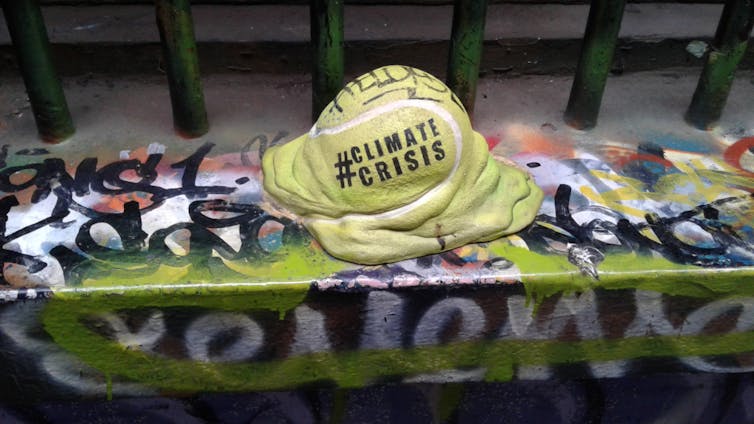 A melting tennis ball appeared in Melbourne’s Hosier Lane, bearing the hashtag #Climatecrisis.
Black Mark Melbourne Art & Culture Critic
A melting tennis ball appeared in Melbourne’s Hosier Lane, bearing the hashtag #Climatecrisis.
Black Mark Melbourne Art & Culture Critic
Soon after the bushfires, the spread of a new coronavirus led to the declaration of a global pandemic. Lockdowns and states of emergency were implemented in numerous countries from March onwards. Despite stay-at-home orders, graffiti and street art have appeared on walls in cities all over the world.
Much of this was about the pandemic itself. During Melbourne’s first lockdown from March to early June, posters satirised the hoarding of toilet paper or showed Bart Simpson saying “ay corona”. Some artists simply wrote “COVID-19” as if it was a graffiti tag, evoking the tag names of decades gone by in New York and other American cities.
After the second wave of coronavirus infections hit Victoria in July, Melbourne’s lockdown intensified. Street art reflected the divided views expressed in media and political debates about public health. An artist added the words “MOCKING SCIENCE” to a “STOP” sign, perhaps as a riposte to COVID-deniers or anti-mask campaigners. Others wrote on bridges over freeways “the government lies” and “it’s just a flu”.
As this second lockdown went on, artists’ activities became more elaborate and more emotional. In South Melbourne, one mural revised Michelangelo’s The Creation of Adam, which shows God giving life to Adam and is famed for its almost-touching fingers. This rendition placed the two figures far apart and put the words “physical distancing” between them.
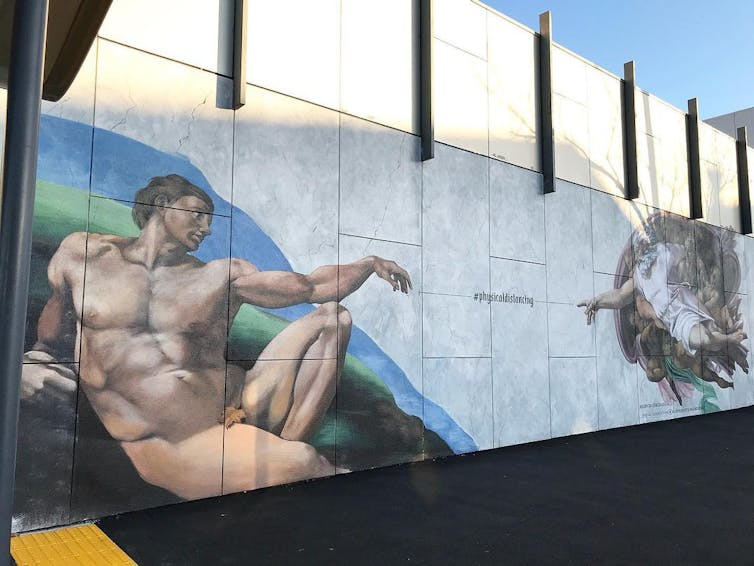 This South Melbourne mural turned iconic art into a message about physical distancing under COVID-19.
Instagram/streetart_melbourne
This South Melbourne mural turned iconic art into a message about physical distancing under COVID-19.
Instagram/streetart_melbourne
Separation from friends and family members generated extensive anxiety and sadness in lockdown. Posters in Fitzroy exhorted us to “Be kind. Let’s look out for one another” and reminded us that “kindness is contagious too”. In Brunswick, one artist created posters evoking the semi-abstract figures of Matisse, with two people embracing, surrounded by the words “together soon enough”. Frequently, individuals simply condensed their emotions into two words, writing “fuck corona”.
As Melbourne’s harsh second lockdown ended, well-known artist Lushsux painted a mural of Victorian Premier Daniel Andrews, posting a photograph on Instagram accompanied by a voice-over criticising Andrews for “the longest and most severe lockdown probably in the entire world”.
The killing of George Floyd by a police officer in Minneapolis on May 26 led to widespread unrest in America, Australia and around the world. Artists both protested and memorialised his death. Murals, usually showing Floyd’s face and often including phrases such as “Say his name” and “I can’t breathe”, appeared in dozens of cities, including Barcelona, New York, London, Berlin, Los Angeles, Binnish in Syria, and in Minneapolis itself.
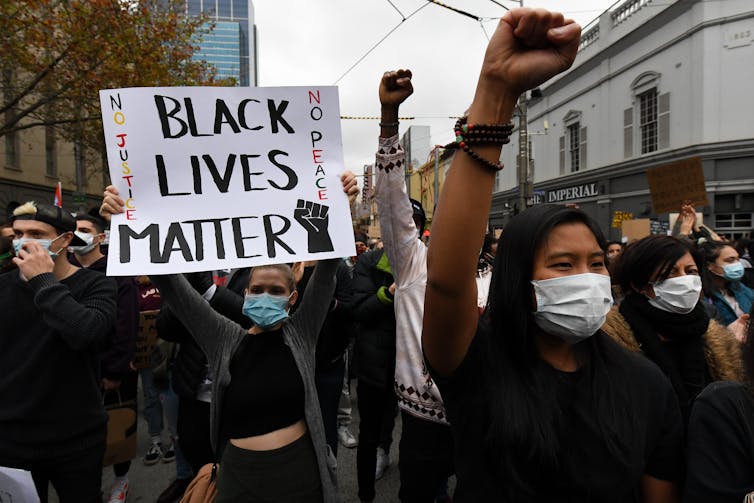 The Black Lives Matter protests gave rise to much new street art in Australia, just as the arrival of the coronavirus pandemic had done.
James Ross/AAP
The Black Lives Matter protests gave rise to much new street art in Australia, just as the arrival of the coronavirus pandemic had done.
James Ross/AAP
In Melbourne, posters proclaiming “Cops are not our friends” and the spray-painted slogan “NO JUSTICE NO PEACE” appeared in Hosier Lane, as the same messages sprung up in London and New York. Black Lives Matter protests were held in several Australian cities.
Artists contributed temporary and more long-lasting interventions. Pieces of cardboard were left propped up against trees in the Exhibition Gardens in Melbourne, stating “432 Deaths in Custody” and “Justice for Tanya Day”. On the outside wall of the Tote Hotel in Collingwood, Melbourne, someone had written “END ABORIGINAL DEATHS IN CUSTODY” in huge white capital letters.
Although much street art is anonymous, some makers sign their street artworks. During 2020, two artists stood out for their creation of highly political artworks.
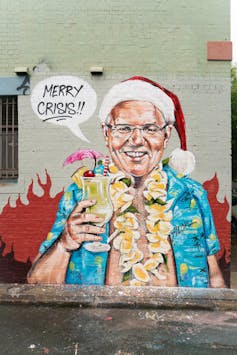 Artist Scott Marsh’s depiction of Scott Morrison, who was widely criticised for being on holiday in Hawaii while bushfires raged in Australia.
scottmarsh.com.au
Artist Scott Marsh’s depiction of Scott Morrison, who was widely criticised for being on holiday in Hawaii while bushfires raged in Australia.
scottmarsh.com.au
In Sydney, having painted Prime Minister Scott Morrison on holidays while bushfires blazed in Australia in December 2019, Scott Marsh continued to paint murals that pressed buttons on hot topics throughout 2020. He followed up his Morrison-in-Hawaii mural with one of climate deniers and, in June, a mural in Redfern of a burning police van, which was removed within 24 hours of it being completed.
As US President Donald Trump protested that the election outcome in November was based on fake results, Marsh took inspiration from CNN anchor Anderson Cooper’s description of Trump as a turtle flailing on its back in the sun. Marsh painted this as a cartoonish mural on the wall of a Newtown pub. (Marsh’s website is also selling T-shirts of Trump as a turtle.)
As 2020 came toward an end, with everyone hoping for respite from the crises that had dominated their lives, Melbourne artist Julie Shiels created an art installation in the streets of Fitzroy that seeks to keep politics in the minds of the public.
The Grandmasters is a series of paste-ups featuring famous artworks altered to include the heads of Australian politicians. From their mouths, speech bubbles emit comments made by them in 2020. The series includes 12 separate works, pasted along a hoarding at a construction site.
It features federal government ministers such as Alan Tudge and Josh Frydenberg, former prime minister Tony Abbott and Scott Morrison. Each is featured in an artwork whose scenario relates to the politician’s role. When juxtaposed with the speech-bubble quotations, the painting’s titles provide excoriating political critique.
Frydenberg features in Caravaggio’s The Cardsharps; Morrison is shown in Quentin Massys’s work, The Money Changer and His Wife, saying: “We don’t want to see women rise only on the basis of others doing worse.” Morrison’s mouth is open and he stares directly at the spectator, while the eponymous wife stares resignedly downwards.
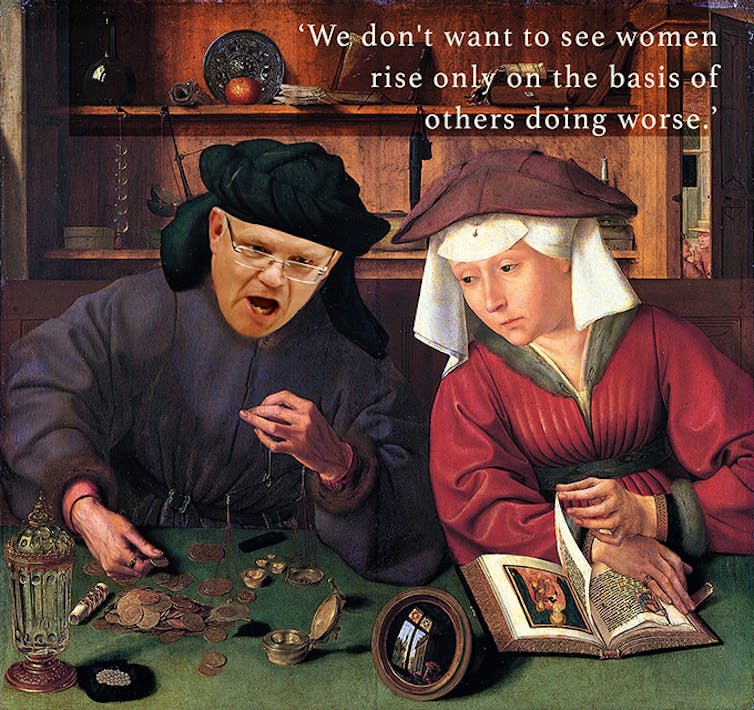 Julie Shiels’s interpretation of Quentin Massys’s The Money Changer and His Wife.
Julie Shiels
Julie Shiels’s interpretation of Quentin Massys’s The Money Changer and His Wife.
Julie Shiels
The only non-Australian politician featured is Donald Trump, shown spliced into Rembrandt’s The Anatomy Lesson saying: “Don’t be afraid of COVID. Don’t let it rule your life.”
And, as if to keep our minds on the issue that began the disasters of 2020, Shiels includes a reworked Raft of the Medusa by Gericault with Abbott sitting amid dead and dying refugees on a sinking raft, saying: “Climate change is crap.”
Despite the seemingly endless series of disasters in 2020, we can take some comfort and inspiration from the ways in which so many artists expressed their views on the walls and in the streets of Australia.
Authors: Alison Young, Francine V. McNiff Professor of Criminology, University of Melbourne
Read more https://theconversation.com/getting-to-the-street-art-of-a-year-like-no-other-149923





